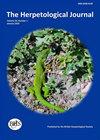隐藏在视野中:中部高原暗色响尾蛇在人为景观中的可探测性和栖息地选择
IF 0.6
4区 生物学
Q3 ZOOLOGY
引用次数: 0
摘要
人类活动导致了世界各地生物群落的几次变化。一些物种通过不同的适应在改变的环境中维持着可存活的种群,然而,对于包括爬行动物在内的某些分类群来说,这方面的知识很少。我们分析了响尾蛇Crotalus triseriatus的可探测性和栖息地选择,以帮助我们了解该物种如何应对人为景观变化。通过视觉接触调查,在两处人工景观中对响尾蛇进行了为期两年的监测。我们分析了气候因素和人类活动的可探测性,并分析了原生和非原生植被的栖息地选择。我们的研究表明,在人类化的景观中,C.triseriatus的可检测性受到不同的影响;人类活动可能是农田等景观的决定因素,而气候因素可能是人类活动较少的景观的决定因子,如城市公园内的保护区。栖息地选择的分析表明,原生植被对所研究景观中C.triseriatus的持久性至关重要。有几种策略可以让响尾蛇在不同的人工景观中生存;尽管如此,为了保护野生动物,应该在有人居住的地区保护原生栖息地遗迹。本文章由计算机程序翻译,如有差异,请以英文原文为准。
Hidden in plain sight: detectability and habitat selection
of the central plateau dusky rattlesnake in anthropized landscapes
Human activities have caused several changes in biotic communities all over the world. Some species maintain viable populations in altered environments through different adaptations, however, knowledge in this regard is scarce for certain taxa, including reptiles. We analysed the detectability and habitat selection of the rattlesnake Crotalus triseriatus to contribute to our knowledge about how this species responds to anthropogenic landscape change. Rattlesnakes were monitored for two years in two anthropized landscapes using visual encounter surveys. We analysed detectability in relation to climatic factors and human activity, and habitat selection was analysed in native and non-native vegetation. Our study shows that detectability of C. triseriatus is differentially affected in anthropized landscapes; human activity may be determinant in landscapes such as agricultural fields, whilst climatic factors may be determinant in landscapes where people are less active such as the protected areas within urban parks. The analyses of habitat selection shows that native vegetation is crucial for the persistence of C. triseriatus in the studied landscapes. Several strategies may allow rattlesnakes to persist in different anthropized landscapes; nonetheless, native habitat remnants should be protected in anthropized areas to conserve wildlife.
求助全文
通过发布文献求助,成功后即可免费获取论文全文。
去求助
来源期刊

Herpetological Journal
生物-动物学
CiteScore
2.40
自引率
10.00%
发文量
25
审稿时长
>12 weeks
期刊介绍:
The Herpetological Journal is the Society''s prestigious quarterly scientific journal.
 求助内容:
求助内容: 应助结果提醒方式:
应助结果提醒方式:


